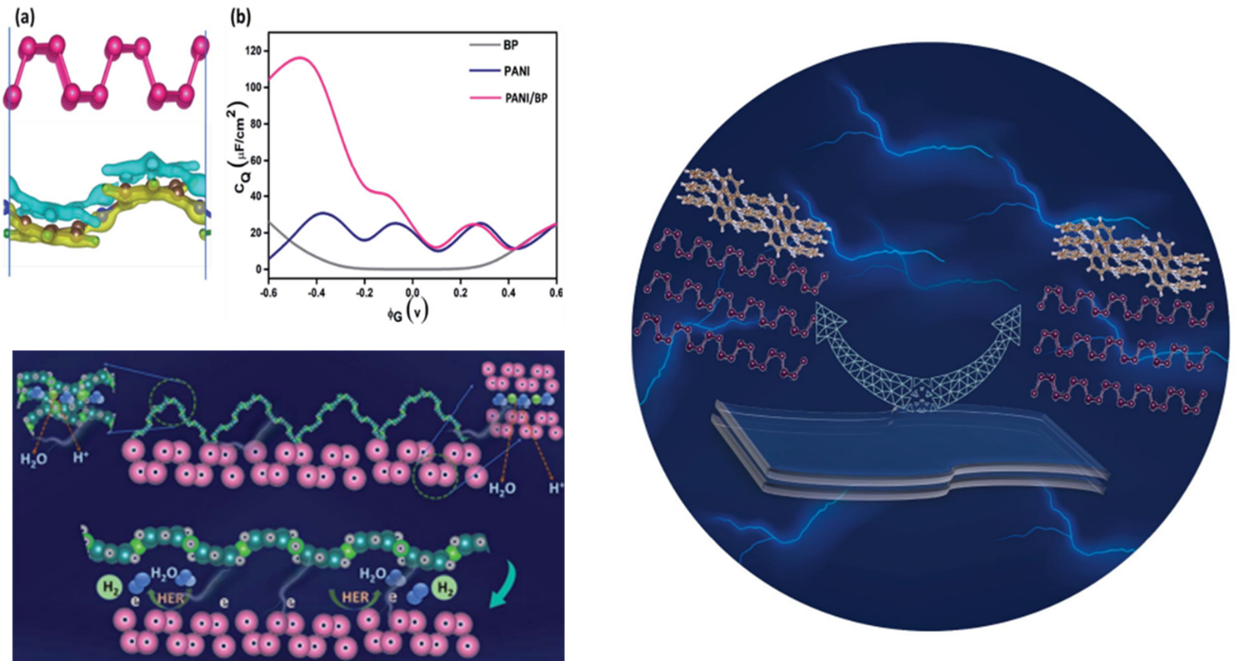 Research at the Department of Physics has effectively produced and characterised BP nanosheets on a large scale by a simple solvothermal approach, and the formation mechanisms are discussed. The paper, 2D-Black Phosphorus/Polyaniline Hybrids for Efficient Supercapacitor and Hydrogen Evolution Reaction Applications Check for updates, has been published by Prof Ranjit Thapa, Associate Dean of Sciences, as a corresponding author, and his PhD student, Mr Samadhan Kapse in Sustainable Energy & Fuels having an Impact Factor of 6.367.
Research at the Department of Physics has effectively produced and characterised BP nanosheets on a large scale by a simple solvothermal approach, and the formation mechanisms are discussed. The paper, 2D-Black Phosphorus/Polyaniline Hybrids for Efficient Supercapacitor and Hydrogen Evolution Reaction Applications Check for updates, has been published by Prof Ranjit Thapa, Associate Dean of Sciences, as a corresponding author, and his PhD student, Mr Samadhan Kapse in Sustainable Energy & Fuels having an Impact Factor of 6.367.
Abstract
Black phosphorous (BP) is an emerging 2D material with exciting physicochemical properties with broad applicability in electronics. Stability in the ambient environment, large-scale synthesis, and volume expansion during the charge/discharge process hinder its application in energy storage. Here, we report a facile gram-scale synthesis of BP in a mild reaction condition by a simple and cost-effective wet chemical method. To overcome its degradation and sluggish electrochemical performance, an organic hybrid with polyaniline is also prepared. Further, we fabricated a flexible supercapacitor device which results in an exceptional specific capacitance of 969 mFcm-2 at a current density of 0.4 Acm-2, which displayed a high energy density of 21.5 mWhkg-1 at a power density of 231 mWkg-1 with good cycling stability of 91% after 4000 charge-discharge cycles. Similarly, the cyclic voltammetry studies of the flexible devices at various bending angles display a similar CV profile for all the bending angles, which confirms the device’s reliability for flexible applications.
Explanation of the research
BP-PANI hybrid materials were prepared by the in-situ chemical oxidation method. By this approach, the researchers got highly stable BP by an inorganic-organic linkage, and its energy storage performance was also investigated. The fabricated symmetric flexible supercapacitor device based on BP/PANI heterostructure exhibited an extraordinary specific capacitance of 969 mFcm-2 at a current density of 0.4 Acm-2. Moreover, the fabricated device showed a high energy density of 21.5 mWhkg-1 and a power density of 231 mWkg-1 with impressive cycle stability of 91% after 4000 charge-discharge cycles. This study paves the way for future research into gram-scale BP synthesis, stability via an inorganic-organic coupling, and its potential application in electrochemical energy storage devices.
Social implications of the research
With the rapid growth of portable/flexible electronics and the high demand for clean energy, supercapacitors have sparked interest due to their advantages of fast charge/discharge rates, long cycle life, and high-power density compared to conventional energy-storage devices such as dielectric capacitors and Li-ion batteries. Likewise, developing new functional materials with outstanding properties could shed light on many issues, including pollution, energy, synthesis, and cost. In recent years few graphene analogues materials have been explored, and because of their tuneable physicochemical properties, they were used in energy storage applications. Generally, black phosphorus was synthesised from polymorphs of phosphorus under vigorous reaction conditions. However, these high temperature/pressure conditions suffer from safety, toxicity, controllability, and gram-scale production.
Quantum capacitance is an efficient tool for rapidly screening materials for supercapacitor applications and therefore is the future of this research. The researchers have collaborated with Mr Namsheer K, Mr Mridula Manoj, Mr Aditya Sharma, and Dr Chandra Sekhar Rout from the Functional Materials & Devices Laboratory, Centre for Nano Material Sciences, Jain University, Bangalore, India, in this work.

